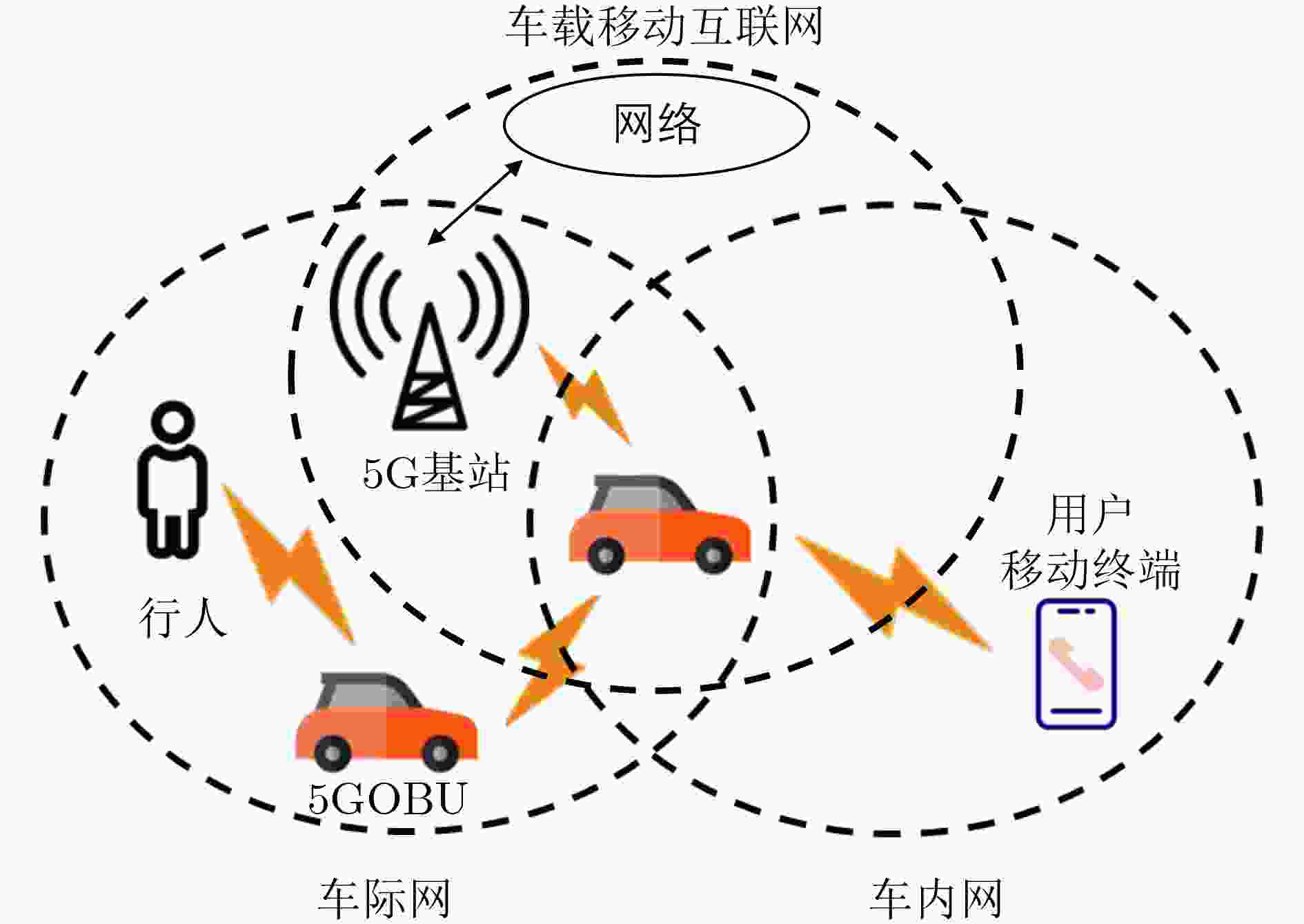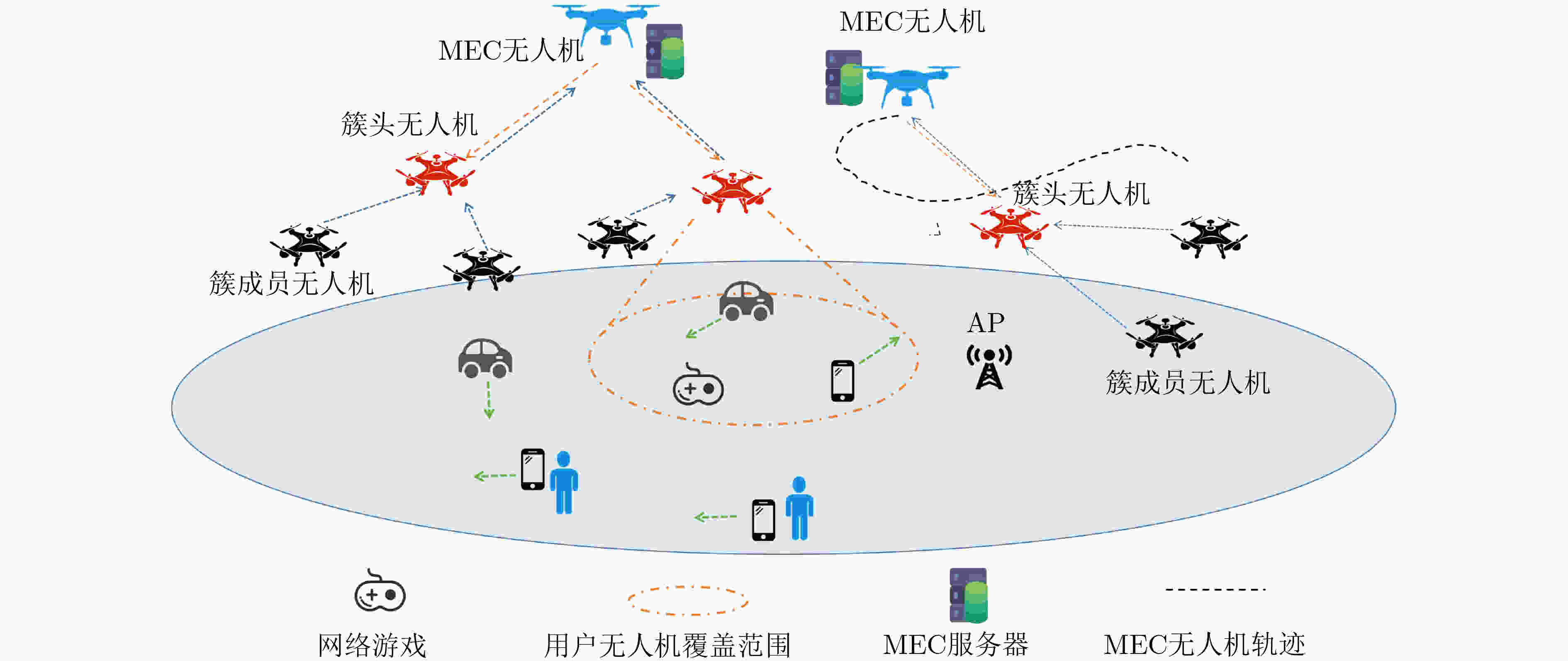Overview on Medium Access Control Protocol in Flying Ad-hoc NETworks and Vehicular Ad-hoc NETworks
-
摘要: 随着移动通信技术的迭代更新,车联网(VANET)和无人机自组网(FANETs)已成为通信网络的重要组成部分,而媒体接入控制(MAC)协议则是移动自组织网络未来发展的核心研究内容之一。安全控制信息和用户业务信息是自组织网络最主要的两类信息,而两者不同的服务质量(QoS)需求对MAC机制的设计带来了严峻的考验。该文主要考虑车联网和无人机自组网,针对其网络特征,从不同的优化目标出发,对其使用的MAC协议进行分析与归纳,并对下一步的研究方向进行了思考与展望。Abstract: With the iterative update of mobile communication technology, Vehicular Ad-hoc NETworks (VANETs) and Flying Ad-hoc NETworks (FANETs) have become significant parts of the communication network, and the Medium Access Control (MAC) protocol is one of the core research contents of the future development of Mobile Ad-hoc NETworks (MANETs). Security control and user service are the two principal types of message in Ad-hoc networks, where their different Quality of Service (QoS) requirements bring severe challenges to the design of MAC mechanism. In this paper, VANETs and FANETs are mainly taken into consideration. According to their network characteristics and different optimization objectives, the MAC protocols used in them are analyze and summarized, while the future research directions are discussed and prospected.
-
表 1 MAC协议分类
分类方式 类型 特点 分配信道方式 基于竞争类 按需使用信道,适用于上层数据较少且节点个数较少的场景 基于预留类 通过协议本身的调度保证节点可以公平有序地使用频谱资源 混合类 竞争类&预留类,兼顾两者 信道使用数目 单信道 所有的安全控制信息和用户业务信息在同一个信道上发送和接收 双信道 有两个共享信道:控制信道和业务信道 多信道 节点可以在多个信道上发送和接收 网络控制类型 集中式 存在中心节点,业务集中处理 分布式 不存在中心节点,通信控制功能分布在各个节点上 表 2 车联网和无人机自组网特点对比
特征 车联网 无人机自组网 网络规模 大,主要限制在地面活动 更大,在3维空间移动 移动性 快,通常在6~30 m/s,受道路约束大 高速,通常在0~130 m/s 能源限制 由车载电池或者独立电池供能 无人机电量很受限,电量会影响载重和续航时间 应用场景 交通和天气信息,警报和位置服务,信息娱乐系统等 救援行动,农作物调查,野生生物搜索,救灾应急等 表 3 根据优化目标对车联网的MAC协议进行分类
表 5 无人机自组网的MAC协议特性整理
协议 特点 缺点 实验场景 高吞吐量原则 FRMA控制
协议[49](1)可以实现即时报文传输任务和多报文接收,提高了实时性;
(2)采用反馈重传机制,吞吐量得到了有效提高。(1)采用反馈重传机制增加了端到端的时延;
(2)流量负荷需根据时效性和可靠性的具体要求进行限制,不能做到自主化。模拟空对地的攻击任务,分4组共40架无人机完成对地面目标的打击;任意两组之间的距离均大于
2 km;集群之间可以进行信息传递。低功耗原则
低丢包率原则ELMAC协
议[50](1)基于萤火虫优化方案提供可靠的QoS指标;
(2)设计了有效的避碰、拥塞控制和节能算法。在MAC层捕获,耳聋问题并未得到解决。 由5~20架无人机构成无人机自组网,通过全向天线进行通信; 低丢包率原则
高吞吐量原则LMAC协
议[51](1)无人机可以通过学习最佳传输策略以确定最佳时隙和天线方向;
(2)克服了由于无人机的移动性引起的随机信道增益问题。(1)该协议需要地面基站进行辅助控制来消除干扰,场景限制较大;
(2)对于传输功率控制和数据速率的研究不足。由20架无人机构成无人机自组网,
地面站与无人机的距离为20~
400 m。高吞吐量
原则FS-MAC协
议[28](1)具有容错同步交换MAC协议功能;
(2)在考虑故障的无人机的情况下,实现多无人机之间的同步切换一致性。(1)条件限制太多,无法进行大规模的实验模拟;
(2)未考虑其他无人机自组网突发真实实验情况,如协议切换失败如何处理。均匀分布在球体空间的5~12架无人机组成的中小型无人机自组网结构,无人机之间均可以相互通信。 FMAC协
议[52](1)以较低的成本在密度变化的集群场景实现较高的可靠性;
(2)在接收到数据包有限的情况下也可以调整竞争窗口的大小,避免信道恶化。(1)无法实时调节更新竞争窗口的间隔长度和大小;
(2)对于周期性单跳数据包的传输,无人机集群的飞行环境过于简单。自由空间中的蜂拥,无人机群密度会变密,且存在4个圆形障碍物;每架无人机从移动的虚拟中心获取信息。 低功耗原则
低丢包率原则FM-MAC协
议[53](1)将多信道与定向天线结合以提供不同的QoS保障;
(2)针对链路中断问题,提供了基于移动预测的信道预约方案。固定长度的控制信道间隔和业务信道间隔无法根据不同分组的流量需求调整,不利于动态的网络环境。 所有无人机均配备相同的天线和无线电以进行通信;天线可以工作在全向模式或定向模式。 信道接入优先性原则 MCLA协
议[54](1)支持多个业务类,并保障最高优先级业务的极低时延和极高传输速率;
(2)采用自适应退避算法,灵活调节竞争窗口;
(2)根据信道的忙闲程度,控制业务信息对信道的访问。(1)并未详细阐述其他不同优先级的业务如何保障QoS;
(2)该文假设过多,无法在真实场景中完美应用。无人机随机分布在空间中,以随机方向进行匀速线性运动。 低功耗原则
高吞吐量原则FA-MMAC
协议[55](1)通过子信道的划分和多波束的复用,从空间和频域分配资源;
(2)解决了定向传输、隐藏终端和耳聋等干扰问题;
(3)无人机之间的并行传输能力得到了提升。(1)该协议对于波束的切换问题研究较少,需要进行改进以减少无人机移动性带来的影响;
(2)假设情况下物理信道中误码率为0,且不存在传输延迟,这在现实场景下基本不存在。由在相同高度飞行的无人机集群组成无人机自组网,并采用GPS进行同步。 表 6 根据优化目标对无人机自组网的MAC协议进行对比分析
协议 端到端时延(s) 平均吞吐量(Mbps) 传输率PDR(%) 位置感知 集中式 EL-MAC协议 低 较低 超过90 有 FS-MAC协议 高 高 – – 分布式 FM-MAC协议 较高 较高 近100 有 MCLA协议 较低 低 – – -
[1] KATSIGIANNIS P, MISOPOLINOS L, LIAKOPOULOS V, et al. An autonomous multi-sensor UAV system for reduced-input precision agriculture applications[C]. 2016 24th Mediterranean Conference on Control and Automation (MED), Athens, Greece, 2016: 60–64. [2] ZENG Yong, ZHANG Rui, and LIM T J. Wireless communications with unmanned aerial vehicles: Opportunities and challenges[J]. IEEE Communications Magazine, 2016, 54(5): 36–42. doi: 10.1109/MCOM.2016.7470933 [3] LIU Yajun, ZHU Congxu, DENG Xiaoheng, et al. UAV-aided urban target tracking system based on edge computing[J]. arXiv: 1902.00837, 2020. [4] JIANG D and DELGROSSI L. IEEE 802.11p: Towards an international standard for wireless access in vehicular environments[C]. VTC Spring 2008-IEEE Vehicular Technology Conference, Marina Bay, Singapore, 2008: 2036–2040. [5] IEEE. IEEE Std 1609.1-2006 IEEE trial-use standard for wireless access in vehicular environments (wave)-resource manager[S]. New York, USA: IEEE, 2006: 1–71. [6] IEEE. IEEE Std 1609.2-2006 IEEE trial-use standard for wireless access in vehicular environments-security services for applications and management messages[S]. New York, USA: IEEE, 2006: 1–105. [7] IEEE. IEEE Std 1609.3-2007 IEEE trial-use standard for wireless access in vehicular environments (WAVE)-networking services[S]. New York, USA: IEEE, 2007: 1–99. [8] IEEE. IEEE Std 1609.4-2010 IEEE standard for wireless access in vehicular environments (WAVE)--multi-channel operation[S]. New York, USA: IEEE, 2011: 1–89. [9] MISHRA D and NATALIZIO E. A survey on cellular-connected UAVs: Design challenges, enabling 5G/B5G innovations, and experimental advancements[J]. Computer Networks, 2020, 182: 107451. doi: 10.1016/j.comnet.2020.107451 [10] GURES E, SHAYEA I, ALHAMMADI A, et al. A comprehensive survey on mobility management in 5G heterogeneous networks: Architectures, challenges and solutions[J]. IEEE Access, 2020, 8: 195883–195913. doi: 10.1109/ACCESS.2020.3030762 [11] ISOLANI P H, CLAEYS M, DONATO C, et al. A survey on the programmability of wireless MAC protocols[J]. IEEE Communications Surveys & Tutorials, 2019, 21(2): 1064–1092. doi: 10.1109/COMST.2018.2881761 [12] 吴国栋, 董超, 李艾静, 等. 车辆自组网多信道MAC机制研究综述[J]. 通信技术, 2018, 51(7): 1491–1496. doi: 10.3969/j.issn.1002-0802.2018.07.001WU Guodong, DONG Chao, LI Aijing, et al. Overview on multi-channel MAC mechanisms in vehicle ad hoc network[J]. Communications Technology, 2018, 51(7): 1491–1496. doi: 10.3969/j.issn.1002-0802.2018.07.001 [13] CAO Jin, MA Maode, LI Hui, et al. A survey on security aspects for 3GPP 5G networks[J]. IEEE Communications Surveys & Tutorials, 2020, 22(1): 170–195. doi: 10.1109/COMST.2019.2951818 [14] GARCIA-ROGER D, GONZÁLEZ E E, MARTÍN-SACRISTÁN D, et al. V2X support in 3GPP specifications: From 4G to 5G and beyond[J]. IEEE Access, 2020, 8: 190946–190963. doi: 10.1109/ACCESS.2020.3028621 [15] LI Bin, FEI Zesong, and ZHANG Yan. UAV communications for 5G and beyond: Recent advances and future trends[J]. IEEE Internet of Things Journal, 2019, 6(2): 2241–2263. doi: 10.1109/JIOT.2018.2887086 [16] POPOVSKI P, TRILLINGSGAARD K F, SIMEONE O, et al. 5G wireless network slicing for eMBB, URLLC, and mMTC: A communication-theoretic view[J]. IEEE Access, 2018, 6: 55765–55779. doi: 10.1109/ACCESS.2018.2872781 [17] EZE E C, ZHANG Sijing, LIU Enjie, et al. Advances in vehicular ad-hoc networks (VANETs): Challenges and road-map for future development[J]. International Journal of Automation and Computing, 2016, 13(1): 1–18. doi: 10.1007/s11633-015-0913-y [18] XU Wenchao, ZHOU Haibo, CHENG Nan, et al. Internet of vehicles in big data era[J]. IEEE/CAA Journal of Automatica Sinica, 2018, 5(1): 19–35. doi: 10.1109/JAS.2017.7510736 [19] 任广山, 常晶, 陈为胜. 无人机系统智能自主控制技术发展现状与展望[J]. 控制与信息技术, 2018(6): 7–13.REN Guangshan, CHANG Jing, and CHEN Weisheng. Present and prospect of intelligent autonomous control for UAV[J]. Control and Information Technology, 2018(6): 7–13. [20] WU Hui, HAN Haiting, WANG Xiao, et al. Research on artificial intelligence enhancing internet of things security: A survey[J]. IEEE Access, 2020, 8: 153826–153848. doi: 10.1109/ACCESS.2020.3018170 [21] XIE Junfeng, TANG Helen, HUANG Tao, et al. A survey of blockchain technology applied to smart cities: Research issues and challenges[J]. IEEE Communications Surveys & Tutorials, 2019, 21(3): 2794–2830. doi: 10.1109/COMST.2019.2899617 [22] HEWA T, GÜR G, KALLA A, et al. The role of blockchain in 6G: Challenges, opportunities and research directions[C]. 2020 2nd 6G Wireless Summit (6G SUMMIT), Levi, Finland, 2020: 1–5. [23] ABBAS N, ZHANG Yan, TAHERKORDI A, et al. Mobile edge computing: A survey[J]. IEEE Internet of Things Journal, 2018, 5(1): 450–465. doi: 10.1109/JIOT.2017.2750180 [24] BEKMEZCI I, SAHINGOZ O K, and TEMEL Ş. Flying ad-hoc networks (FANETs): A survey[J]. Ad Hoc Networks, 2013, 11(3): 1254–1270. doi: 10.1016/j.adhoc.2012.12.004 [25] IEEE. IEEE Std 1609.4-2016 IEEE standard for wireless access in vehicular environments (WAVE) -- multi-channel operation[S]. New York, USA: IEEE, 2016: 1–206. [26] JAHN A, DAVID K, and ENGEL S. 5G/LTE based protection of vulnerable road users: Detection of crossing a curb[C]. 2015 IEEE 82nd Vehicular Technology Conference (VTC2015-Fall), Boston, USA, 2015: 1–5. [27] CHENG Xiang, ZHANG Rongqiang, and YANG Liuqing. Wireless toward the era of intelligent vehicles[J]. IEEE Internet of Things Journal, 2019, 6(1): 188–202. doi: 10.1109/JIOT.2018.2884200 [28] NGUYEN V, KIM O T T, PHAM C, et al. A survey on adaptive multi-channel MAC protocols in VANETs using Markov models[J]. IEEE Access, 2018, 6: 16493–16514. doi: 10.1109/ACCESS.2018.2814600 [29] LYU F, ZHU Hongzi, ZHOU Haibo, et al. MoMAC: Mobility-aware and collision-avoidance MAC for safety applications in VANETs[J]. IEEE Transactions on Vehicular Technology, 2018, 67(11): 10590–10602. doi: 10.1109/TVT.2018.2866496 [30] ZHANG Yue, LIU Kai, LIU Shanzhi, et al. A clustering-based collision-free multichannel MAC protocol for vehicular ad hoc networks[C]. 2018 IEEE 88th Vehicular Technology Conference (VTC-Fall), Chicago, USA, 2018: 1–7. [31] LYU F, ZHU Hongzi, CHENG Nan, et al. ABC: Adaptive beacon control for rear-end collision avoidance in VANETs[C]. 2018 15th Annual IEEE International Conference on Sensing, Communication, and Networking (SECON), Hong Kong, China, 2018: 1–9. [32] SHAH A F M S, ILHAN H, and TURELI U. RECV-MAC: A novel reliable and efficient cooperative MAC protocol for VANETs[J]. IET Communications, 2019, 13(16): 2541–2549. doi: 10.1049/iet-com.2018.6171 [33] KARABULUT M A, SHAH A F M S, and ILHAN H. OEC-MAC: A novel OFDMA based efficient cooperative MAC protocol for VANETS[J]. IEEE Access, 2020, 8: 94665–94677. doi: 10.1109/ACCESS.2020.2995807 [34] CAO Yi, ZHANG Haixia, FANG Yuguang, et al. An adaptive high-throughput multichannel MAC protocol for VANETs[J]. IEEE Internet of Things Journal, 2020, 7(9): 8249–8262. doi: 10.1109/JIOT.2020.2990568 [35] LYU F, ZHU Hongzi, ZHOU Haibo, et al. SS-MAC: A novel time slot-sharing MAC for safety messages broadcasting in VANETs[J]. IEEE Transactions on Vehicular Technology, 2018, 67(4): 3586–3597. doi: 10.1109/TVT.2017.2780829 [36] LIN Zhiping, SUN Yanglong, TANG Yuliang, et al. An efficient message broadcasting MAC protocol for VANETs[J]. Wireless Networks, 2020, 26(8): 6043–6057. doi: 10.1007/s11276-020-02415-y [37] GAO Jie, LI Mushu, ZHAO Lian, et al. Contention intensity based distributed coordination for V2V Safety message broadcast[J]. IEEE Transactions on Vehicular Technology, 2018, 67(12): 12288–12302. doi: 10.1109/TVT.2018.2876388 [38] ZHANG Tianjiao and ZHU Qi. EVC-TDMA: An enhanced TDMA based cooperative MAC protocol for vehicular networks[J]. Journal of Communications and Networks, 2020, 22(4): 316–325. doi: 10.1109/JCN.2020.000021 [39] ABD EL-GAWAD M A, ELSHARIEF M, and KIM H. A cooperative V2X MAC protocol for vehicular networks[J]. EURASIP Journal on Wireless Communications and Networking, 2019, 2019: 65. doi: 10.1186/s13638-019-1382-8 [40] DUBE P and WALINGO T. Performance analysis of an adaptive OFDMA-based CSMA/CA scheme on a wireless network[J]. IET Communications, 2020, 14(19): 3480–3489. doi: 10.1049/iet-com.2019.1078 [41] KUMAR S, CHOI S, and KIM H. Analysis of hidden terminal’s effect on the performance of vehicular ad-hoc networks[J]. EURASIP Journal on Wireless Communications and Networking, 2019, 2019: 240. doi: 10.1186/s13638-019-1548-4 [42] ZHAO Yuqiang, ZHANG Xuan, ZHENG Rongping, et al. Analysis on merging collision probability in TDMA based VANET[C]. 10th EAI International Conference on Wireless and Satellite Systems, Harbin, China, 2019: 3–12. [43] KUMAR S and KIM H. BH-MAC: An efficient hybrid MAC protocol for vehicular communication[C]. 2020 International Conference on Communication Systems & Networks (COMSNETS), Bengaluru, India, 2020: 362–367. [44] DENG Dongxiao, RAO Wenbi, LIU Bingyi, et al. TA-MAC: A traffic-aware TDMA MAC protocol for safety message dissemination in MEC-assisted VANETs[C]. 2020 29th International Conference on Computer Communications and Networks (ICCCN), Honolulu, USA, 2020: 1–9. [45] YANG Yue, KARIMADINI M, XIANG Cheng, et al. Wide area surveillance of urban environments using multiple mini-VTOL UAVs[C]. IECON 2015 - 41st Annual Conference of the IEEE Industrial Electronics Society, Yokohama, Japan, 2015: 795–800. [46] XIAO Pengju, WANG Li, CHUAN Jianbin, et al. Implementation for UAVs aided edge sensing system in wireless emergency communications[C]. 2019 11th International Conference on Wireless Communications and Signal Processing (WCSP), Xi'an, China, 2019: 1–5. [47] LALIBERTE A S and RANGO A. Texture and scale in object-based analysis of subdecimeter resolution unmanned aerial vehicle (UAV) imagery[J]. IEEE Transactions on Geoscience and Remote Sensing, 2009, 47(3): 761–770. doi: 10.1109/TGRS.2008.2009355 [48] RYAN A and HEDRICK J K. A mode-switching path planner for UAV-assisted search and rescue[C]. The 44th IEEE Conference on Decision and Control, Seville, Spain, 2005: 1471–1476. [49] TANG Jinhui, WANG Yequn, DONG Shufu, et al. A feedback-retransmission based asynchronous frequency hopping MAC protocol for military aeronautical ad hoc networks[J]. Chinese Journal of Aeronautics, 2018, 31(5): 1130–1140. doi: 10.1016/j.cja.2018.02.014 [50] VASHISHT S and JAIN S. An energy-efficient and location-aware medium access control for quality of service enhancement in unmanned aerial vehicular networks[J]. Computers & Electrical Engineering, 2019, 75: 202–217. doi: 10.1016/j.compeleceng.2019.02.021 [51] KALWAR S, CHIN K W, and WANG Luyao. An orientation aware learning MAC for multi-UAVs networks[C]. 2019 29th International Telecommunication Networks and Applications Conference (ITNAC), Auckland, New Zealand, 2019: 1–4. [52] ZHANG Min, DONG Chao, and HUANG Yang. FS-MAC: An adaptive MAC protocol with fault-tolerant synchronous switching for FANETs[J]. IEEE Access, 2019, 7: 80602–80613. doi: 10.1109/ACCESS.2019.2920175 [53] HUANG Xinquan, LIU Aijun, ZHOU Haibo, et al. FMAC: A self-adaptive MAC protocol for flocking of flying ad hoc network[J]. IEEE Internet of Things Journal, 2021, 8(1): 610–625. doi: 10.1109/JIOT.2020.3007071 [54] WU Guodong, DONG Chao, LI Aijun, et al. FM-MAC: A multi-channel MAC protocol for FANETs with directional antenna[C]. 2018 IEEE Global Communications Conference (GLOBECOM), Abu Dhabi, United Arab Emirates, 2018: 1–7. doi: 10.1109/GLOCOM.2018.8648025. [55] ZHENG Bo, LI Yong, CHENG Wei, et al. A multi-channel load awareness-based MAC protocol for flying ad hoc networks[J]. EURASIP Journal on Wireless Communications and Networking, 2020, 2020: 181. doi: 10.1186/s13638-020-01797-z [56] XIE Tian, ZHAO Haitao, XIONG Jun, et al. A multi-channel MAC protocol with retrodirective array antennas in flying ad hoc networks[J]. IEEE Transactions on Vehicular Technology, 2021, 70(2): 1606–1617. doi: 10.1109/TVT.2021.3054646 [57] ZHENG Zhigao, SANGAIAH A K, and WANG Tao. Adaptive communication protocols in flying ad hoc network[J]. IEEE Communications Magazine, 2018, 56(1): 136–142. doi: 10.1109/MCOM.2017.1700323 [58] CHEN Xi, HUANG Chuanhe, FAN Xiying, et al. LDMAC: A propagation delay-aware MAC scheme for long-distance UAV networks[J]. Computer Networks, 2018, 144: 40–52. doi: 10.1016/j.comnet.2018.07.024 [59] 刘东, 吴启晖, QUEK T Q S. 面向航空6G的频谱认知智能管控[J]. 物联网学报, 2020, 4(1): 12–18.LIU Dong, WU Qihui, and QUEK T Q S. Spectrum cognitive intelligent management and control for aviation 6G[J]. Chinese Journal on Internet of Things, 2020, 4(1): 12–18. -






 下载:
下载:



 下载:
下载:
